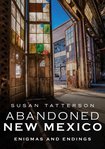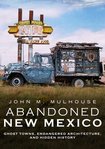

“Tourists Welcome!” shouts the message painted in a script font on the side of the light green building.
Above that are the words, in neat block letters, “Wm. HINDI STORE, General Merchandise, Duran, N.M.”
I drive by the store, abandoned for most of the last 50 years, two or three times a year as I travel north to visit family in Oklahoma. Despite its ghost-town feel, or maybe because of it, I’ve been fascinated with that building since I first encountered it in 1995. Duran lies near the intersection of U.S. Highway 54 and N.M. Highway 3, about halfway between the big metropolises of Corona and Vaughn.
If you take Highway 3 the few short miles north to Encino, you’ll find one of the loneliest roads and one of the most beautiful stretches of land in the state. More than once, I’ve cost myself the 30-minute round-trip detour just to experience the breathtaking views.
Duran is the kind of place I’d like to hang out for a week, and learn as much of its history as possible.
Once, while sitting at the bar of the Dragon Room of the Pink Adobe restaurant in Santa Fe, I happened to sit next to a gentleman who was actually from Duran, and a descendant of William Hindi. I shared my fondness of the place, and he was able to fill me in on some background and history.
I figured that would be the best I could do until recently, when I discovered a book called “Abandoned New Mexico” by John M. Mulhouse. The book’s subtitle is Ghost Towns, Endangered Architecture and Hidden History. In this book, I learned more about the Hindis (they were among several families of Lebanese immigrants who helped settle the town) and Duran’s most notorious crime.
Turns out Duran is the site of New Mexico’s 75th and last legal hanging, as Sheriff John Block oversaw the gallows end of a criminal convicted of a grisly murder. The victim’s wife was only spared because a bullet ricocheted off of her metal corset fastener.
The Duran stories take up only about three pages of Mulhouse’s book. There are 157 more pages with similar delicious details, along with some beautiful photographs, both recent and vintage.
Spending time with the book is like taking a slow drive down New Mexico’s quietest highways, only without the gas expense or that tired feeling of exiting a vehicle you’ve driven for four hours.
Another beautiful book, which works in tandem with Mulhouse’s, is “Abandoned New Mexico: Enigmas and Endings,” by Susan Tatterson.
This book, like others she has done in the Abandoned New Mexico series, features Tatterson’s glorious photographs.
At first glance, the desert seems beige and colorless. After you spend time in and around the desert, though, you notice the detail. The flowers, the variations of green, the effect of the sun’s light, the feathers of the birds, the ever-changing sky, the rocks and so many other things bring immense depth of color just beneath the surface.
That is the way Tatterson’s photos work. She enters an old, dusty abandoned building, but with her camera’s eye finds the hint or, in some cases, blast of color.
Both Tatterson and Mulhouse’s books are part of the America Through Time collection. You can learn more at www.through-time.com.
Few activities are better suited to the Time of Coronavirus than driving around our beautiful New Mexico, finding lonely, forgotten outposts that bring their own feel of nostalgia and beauty. These books are great guides for that endeavor.
Richard Coltharp, publisher of Desert Exposure, has always love exploring abandoned buildings. Two of his New Mexico favorites are the old Cedarvale schoolhouse almost smack dab in the middle of the state, and the Murray Hotel in downtown Silver City, years prior to its wonderful restoration. He can be reached at richard@lascrucesbulletin.com.